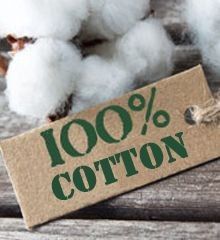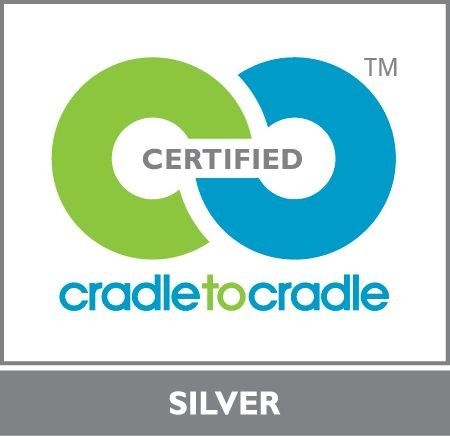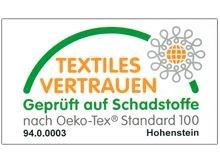CRADLE TO CRADLE® Bio-Degradation
BIO-DEGRADATION EXPLAINED
TRIGEMA Change® is part of a new strategy towards healthy and environmental friendly clothing: Organic products made of 100% organic cotton optimised according to Cradle to Cradle® standards. All Cradle to Cradle Certified® products made by TRIGEMA have been optimised for biological recycling in cooperation with the international environmental institute named EPEA.
THE CRADLE TO CRADLE® PRINCIPLE
This system is closely modelled after the natural systems. Its foundation are closed circuits, which do not generate waste and help us to preserve valuable resources for future generations. The organic garments we developed are products that:
• Utilise resources instead of consuming them
• Are 100 per cent composed of wholesome, non-critical substances
• Are of particularly high quality
• Their raw materials have been produced in an ecologicallysafe manner
• The resources used for their production can be reinserted into the nutrient cycle when the product reaches the end of its usefulness
• They never turn into waste
• Neither their manufacturing process nor the products themselvesgenerate any unusable or toxic substances
In short, these products are: Organic. Cradle to Cradle Certified®. Produced locally and fairly.



The difference between conventional and Cradle to Cradle Certified® products
The "Cradle to Cradle®" concept is based on a vision of an industrialised society that models its production processes on nature.
Nature does not produce waste, as it makes use of the right substances at the right time, wherever they are found. It sums up the idea of designing products and manufacturing processes in such a way that the raw materials and ingredients used will turn into nutrients rather than waste after they have been utilised or consumed. The main objective is to develop high-quality, recyclable materials and goods and transform linear flows of fabric flows to premium recyclables.
The Cradle to Cradle® concept follows the economic principle applied by nature, which is based on closed cycles. According to this principle, all parts consider themselves to be a part of the whole and mutually benefit, promote, transform and recreate without losing anything or leaving anything unusable behind. For instance, try imagining a tree as a production facility of leaves. Its basis of existence and raw material source are the nutrients contained in the soil. It uses water and sunlight to convert this raw material for the purpose of producing fruits and leaves. When the leaves drop to the ground in the autumn, they will not remain there as useless waste, but serve as nutrient for countless micro -organisms which will then decompose and utilise the leaves before returning them to the ground in the shape of topsoil. This topsoil, in turn, receives its nutrients from the ground which simultaneously serves as a source of nutrients for the tree. The result is a perfect metabolism in which the product "leaves" circulates.
To allow this cyclic principle to be applied to our economy, the Cradle to Cradle® concept divides products into two different groups and cycles.
DURABLES
Products that are manufactured for long-term use such as cars, household appliances, carpets, office furniture or synthetic fibres are labelled as durable goods under the Cradle to Cradle® concept. Their components include high quality materials which are designed to last for a long time such as plastics or metals. These materials are integrated into a technical "nutrient" cycle which is intended to turn them into dynamic, yet residual goods that will remain useful in the long term. What this means for durable goods is that the products need to be designed in such a way that the raw materials used can be sorted and recycled without any loss in quality. It will then be possible to use them as the basis for creating new products of equal quality, thereby creating a genuine, endless cycle of materials that does not produce any waste.
THE COMPOSTING PROCESS



Please note: Should your TRIGEMA Change shirt have any buttons attached to it, please remove them before composting the shirt and add them into plastic recycling.
CONSUMABLES
Products that are made of biodegradable substances or have a limited useful life are defined as consumables in accordance with the Cradle to Cradle® concept. Examples include textiles composed of natural fibres, cosmetics, food, cleaning agents and detergents, diapers or packaging materials suitable for singular use. Following Cradle to Cradle® principles, these consumables are designed in such way that they can be fed back into the biological cycle to serve as nutrients. This purpose requires that all product components be selected so that they are sensible and usable from an ecological standpoint, i. e. that they do not contain any toxic substances.
Making durable goods and consumables based on this principle requires a holistic strategy. In contrast to the procedures commonly applied today, which attempt to filter out anything still usable from waste materials, Cradle to Cradle® design requires that parameters such as recyclability, non-toxicity, and usability be taken into account starting with the product development stage so that products can be designed for nutrient cycles from the onset. Products designed in such a way are capable of solving the raw material and the waste problem at the same time and expose neither man nor the environment to any risk from potentially harmful substances.
Cradle to Cradle® therefore means to design and implement useful, completely recyclable or biodegradable products and production methods of the highest quality.
For more information, go to:
EPEA
McDonough Braungart Design Chemistry
